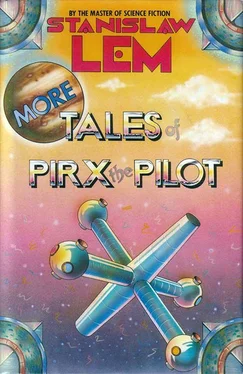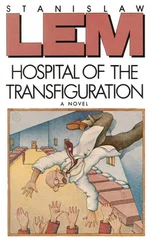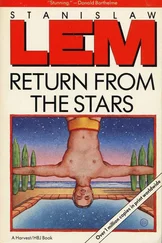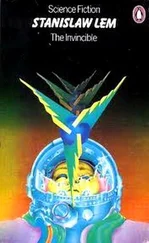Not until the unleashing of atomic energy was the possibility of nuclear tests on Mars broached. One side had to be right. By the mid-twentieth century, it was unanimously agreed that, although Schiaparelli’s geometrical canals were chimerical, there was something up there to suggest the presence of canals. The eye may embellish, but not hallucinate; the canals were observed by too many people, in too many places on Earth, to be an allusion. So: no glacial water, no cloud streams borne along the valleys, and most likely no zones of vegetation, either; yet something was up there—who knew, perhaps even more mind-boggling, more enigmatic—that only awaited the human eye, the camera lens, and unmanned space probes.
Pirx knew better than to divulge the thoughts inspired by these readings, but Boerst, bright and ruthless as befitted the class brain, soon discovered his true sympathies, and for a few weeks made him the laughingstock of the school, dubbing him “Pirx the canalist,” promotor of the doctrine “ Credo, quia non est .” Pirx knew full well the canals were a fiction; worse, that there was nothing even faintly suggestive of them. How could he not have known, what with Mars having been colonized for years, and his having passed his qualifying exams, when he was obliged to orient detailed photographic maps under the vigilant eye of his TA, and even, in his mock-ups, to soft-land in the simulator on the same Agathodaemon floor where he now stood, under the project’s dome, by a bookshelf containing two centuries of astronomical discoveries and antique museum pieces. Yes, he knew, but it was a knowledge of a different order, remote, distanced , not to be verified by tests, by those exercises seemingly based on a hoax. It was as if there existed yet another, inaccessible, geometrically patterned, and mysterious Mars.
There is a stretch on the Ares-Terra line, a zone from which one can really see—continually, for hours on end—with the naked eye what Schiaparelli, Lowell, and Pickering were able to observe only during brief interludes of atmospheric stability. Through the ports one can see the canals, for up to twenty-four, sometimes forty-eight hours, vaguely outlined against the drab, inhospitable shield. Then, as the globe begins to swell on approach, they commence to fade, to dissolve, blurring one by one into a blank nothingness, leaving only the planet’s disk, purged of any sharp contours, to mock with its tedious gray nullity the hopes and expectations it had aroused. True, weeks later, certain surface details, fixed and well defined, begin to re-emerge, but these turn out to be the serrated rims of the largest craters, the wild accretions of weather-beaten rocks, a riot of rock scree buried under deep layers of drab sand, in no way evocative of that pristine, impeccable geometry. At close range, the planet yields its chaos, meekly and irrevocably, incapable of shedding that glaring image of a billion-year erosion; of a chaos not to be reconciled with that memorably lucid design, whose symmetry connoted something compelling, moving, which bespoke a rational order, an unintelligible but manifest logic, that required just a trifle more exertion to be grasped.
Where was that order, and whence came this mocking illusion? Was it a projection of the retina, of human optical processes? A figment of the cerebral cortex? The questions remained unanswered as the problem went the way of all hypotheses phased out and crushed by technological progress: It was swept into the trash. Since there were no canals—not even any topographical features to foster the illusion—the case was closed. A good thing that neither the “canalists” nor the “anti-canalists” lived to hear these sobering revelations, because the riddle was never really solved, merely phased out. Other planets had nebulous shields, and not a single canal was ever sighted on them. Unseen, uncharted. Why? Anyone’s guess.
Here, too, hypotheses could be advanced to explain this chapter of astronomy: the combination of distance and optical enlargement, of objective chaos and a subjective craving for order; the residual traces of something that, emerging from the blurred patch in the lens, just beyond the border of perceptibility, momentarily came within the eye’s grasp; the faintest visual suggestion combined with subconscious wishful thinking.
Requiring all to choose sides, entrenched in their respective positions, forever joined in noble conflict, generation after generation of astrophysicists had gone to the grave firmly believing that the issue would one day be resolved by the appropriate tribunals, fairly and irrevocably. Pirx was sure that all—each in his own way, each for a different reason—would have felt cheated, disillusioned, if they, like he, had been made privy to the truth. For in this refutation of both pro and con, in the total impropriety of any concept vis-à-vis the enigma, was contained a bitter but dire, cruel but salutary lesson which—it suddenly dawned on him—bore directly on the present, on this brain-teaser of a calamity.
A link between the old astrography and the crack-up of the Ariel? But how? And what to make of this intuition, so vague and yet so compelling? A teaser, all right. But whatever the missing link between them, however distant and tenuous the connection, he knew it would no more be revealed now, in the middle of the night, than it would be forgotten. He would have to sleep on it.
As he switched off the light, it occurred to him that Romani was a man of much broader intellectual horizons than he had given him credit for. These books were his own private possession, and one had to fight for every kilo of personal gear shipped to Mars—special notices, appealing to the work crew’s loyalty and warning against the dangers of overloading, were plastered all over the Base, Earthside. Everywhere they were crying for expediency, and here was Romani, coordinator of the Agathodaemon project, who, in flagrant violation of the rules, had imported dozens of kilos of utterly useless books—and for what? Surely not for bedtime reading.
In the dark, already half asleep, he smiled as he realized the motive that justified the presence of these bibliophilic antiquities under the project’s dome. Granted, these books, these passé gospels, these discredited prophecies, had no business being there. But it seemed only fair—necessary, even—that these minds, which had once been the bitterest of enemies, which had given their best to the mystery of the red planet, should find themselves, now fully reconciled, here on Mars. They deserved it, and Romani, who understood, was a man worthy of his trust.
At 0500 hours, he woke from a deep sleep, as alert as if braced by a cold shower. Savoring a few minutes’ leisure—exactly five; it was becoming something of a habit—he thought of the commander of the shipwrecked Ariel. He wasn’t sure whether Klyne could have saved the ship with its thirty-man crew, or whether the man had even tried. Klyne belonged to a generation of rationalists, men trained to keep pace with their impeccably logical allies, the computers, which became more demanding as one made greater efforts to control them; in a sense, blind obedience was the wiser course. But Pirx was incapable of blind obedience. Distrust was in his bones. He flipped on the radio.
The furor had started. Pirx had been expecting it, but he’d underestimated the extent of it. The press kept hammering away at three themes: the suspicion of sabotage, the risk to the other Mars-bound ships, and, of course, the political fallout. The big papers tiptoed around the sabotage hypothesis, but the tabloids wallowed in it. The hundred-thousand-tonners also took flak: they weren’t flightworthy, they couldn’t lift off from Earth, and worse, they could neither abort a mission (their fuel supply was inadequate) nor be junked in circum-Martian orbits. It was true: they had to land on Mars. But three years before, unbeknownst to these self-styled experts, a test prototype equipped with a different computer model had successfully soft-landed on Mars, not once but several times. The political promotors of the Mars project were also subjected to a campaign of vilification, their critics badmouthing it as sheer lunacy. There were exposures of work-safety violations on both bases, of the project’s rubber-stamping and bench-testing methods, of bureaucratic bumbling among high-ranking administrators—in short, a Cassandralike outcry.
Читать дальше












